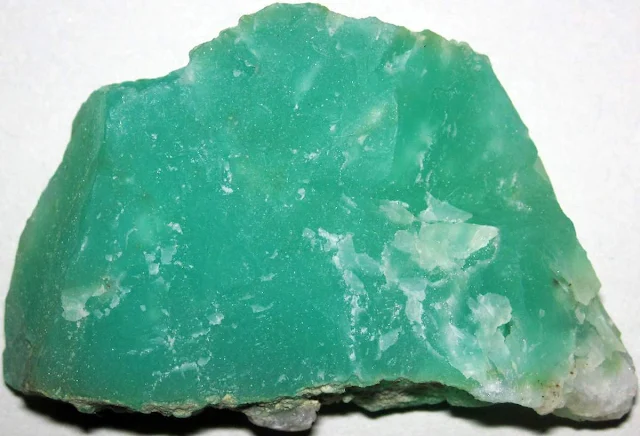What Gemstones Can Be Found in Sedimentary Rocks
Gemstones can be found in sedimentary rocks, but they are less common than in igneous or metamorphic rocks. Sedimentary rocks are formed when layers of sediment build up over time and are compacted and cemented together. Sediment is often weathered and eroded from other rocks.
While most gemstones are found in igneous or metamorphic rocks, there are a few that can be found in sedimentary rocks. These gemstones typically form in sedimentary rocks that are rich in certain minerals, such as calcium carbonate or silica.
.jpg) |
| Photos of Gemstones in Sedimentary Rocks |
Gemstones in Sedimentary Rocks
Gemstones that can be found in sedimentary rocks include
Opal
 |
| Precious Opal Gemstone from Ethiopia's Tertiary Period Photo: James St. John |
Opal is a hydrated silica gel that is often found in sedimentary rocks such as limestone, sandstone, and shale. It is formed when silica-rich water seeps into cracks and cavities in the rock and then evaporates, leaving behind a deposit of opal. Opal can be found in a wide range of colors, including white, black, blue, green, red, and yellow. Some of the most famous opal deposits in the world are located in Australia, Mexico, and Ethiopia.
Turquoise
.jpg) |
| Turquoise (Ithaca Peak Mine, near Kingman, Arizona, USA) Photo: James St. John |
Turquoise is a hydrated copper aluminum phosphate that is often found in sedimentary rocks such as sandstone, shale, and limestone. It is formed when copper-rich solutions react with phosphate-rich solutions in the rock. Turquoise is typically blue-green in color. Some of the most famous turquoise deposits in the world are located in the United States, Iran, and China.
Malachite
Malachite is a copper carbonate hydroxide that is often found in sedimentary rocks such as limestone and sandstone. Malachite is formed when copper-rich solutions react with carbonate-rich solutions in the rock. The copper reacts with oxygen and carbon dioxide to form malachite, which is then deposited in sedimentary rocks. Some of the most famous malachite deposits in the world are located in Russia, the Democratic Republic of the Congo, and Australia.
Azurite
Azurite is a copper carbonate hydroxide that is often found in the same sedimentary rocks as malachite. Azurite is formed in the same way as malachite, but it is more unstable and will often weather to malachite over time. Some of the most famous azurite deposits in the world are located in Namibia, Mexico, and the United States.
Chrysoprase
 |
| Apple-Green Chrysoprase Gemstone from Australia Photo: James St. John |
Chrysoprase is a variety of chalcedony, which is a type of quartz, that is colored green by nickel. It is often found in sedimentary rocks such as limestone and sandstone. Chrysoprase is formed when nickel-rich water flows through cracks and cavities in sedimentary rocks. The nickel reacts with other minerals in the rock to form chrysoprase. Some of the most famous chrysoprase deposits in the world are located in Australia, Germany, and Russia.
Chrysocolla
 |
| Chrysocolla (Kearny area, Arizona, USA) Photo: James St. John |
Chrysocolla is a copper silicate that is often found in the same sedimentary rocks as malachite and azurite. Chrysocolla is formed when copper-rich water flows through cracks and cavities in sedimentary rocks. The copper reacts with other minerals in the rock to form chrysocolla. Some of the most famous chrysocolla deposits in the world are located in the United States, Chile, and Peru.
Diamonds
Diamonds, While diamonds are typically associated with igneous or metamorphic rocks, they can also be found in alluvial deposits derived from the erosion of these rocks. These alluvial diamonds, often found in riverbeds and gravels, are highly sought after for their exceptional hardness, brilliance, and value.
Sapphire and Ruby
.jpg) |
| Rough Sapphire-and-Ruby Specimens |
Sapphires and rubies, both varieties of corundum, are typically found in igneous or metamorphic rocks. However, similar to diamonds, they can also be found in alluvial deposits derived from the erosion of these rocks. Alluvial sapphires and rubies are frequently discovered in riverbeds and gravels.
Gemstone Occurrence in Sedimentary Rocks
Factors Influencing Gemstone Occurrence in Sedimentary Rocks
The presence of gemstones in sedimentary rocks is influenced by several factors, including:
Source Rocks: The presence of gemstone-bearing igneous or metamorphic rocks in the drainage basin of a river or stream increases the likelihood of finding alluvial gemstones.
Transportation Processes: The transport distance and energy of the sedimentary environment play a role in preserving the integrity of gemstones. Harder and more resistant gemstones, such as diamond, sapphire, and ruby, are more likely to survive longer transport distances.
Depositional Environment: The specific sedimentary environment, such as riverbeds, gravel bars, or marine deposits, can influence the concentration and preservation of gemstones.
Diagenesis: The post-depositional processes that alter sedimentary rocks can also affect the formation and preservation of gemstones. For instance, hydrothermal fluids can dissolve and reprecipitate gemstones, leading to the formation of gem-bearing veins or nodules.
Sedimentary rocks offer a diverse range of gemstones, providing a testament to the dynamic geological processes that shape our planet's mineral treasures. Understanding the factors that influence gemstone occurrence in sedimentary rocks is essential for exploration and the pursuit of these valuable gems.
See also:
What Gems Are Found in Igneous Rock
The Differences Between Sedimentary Rocks and Igneous Rocks








